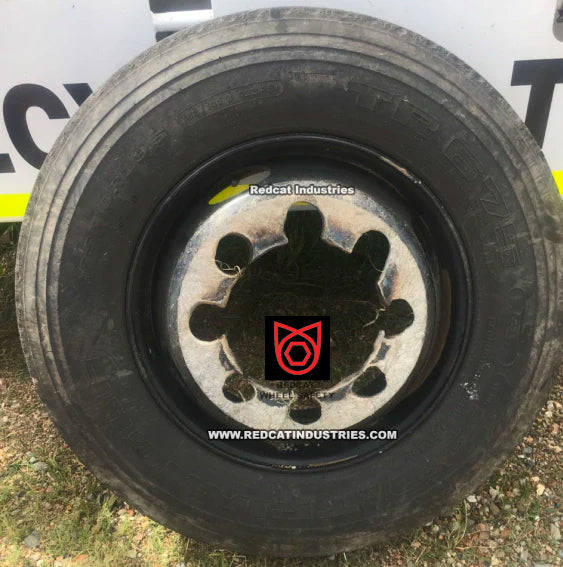SO YOU THINK WHEEL NUTS SIMPLY COME LOOSE?
It is a well-documented fact that loosening wheels are caused by a relaxing of the wheel assembly behind the nut resulting in reduced clamping force, rim movement, fretting of the assembly, and (if not identified early) eventual failure and detachment. Simply preventing the wheel nut from turning will not stop this event from happening, as the reduction of clamping force is taking place within the assembly, not the nut.
There are numerous respected Forensic Investigation, Engineering, and Government websites that analyse the loosening and detaching wheel issue in great detail. A commissioned report by the United Kingdom transport research laboratory has estimated that in the UK alone, 7500-11000 wheel fixing defects are recorded annually (whilst considerably more go unreported).
OF THESE REPORTED FAILURES:
- 45% ARE FAILED WHEEL STUDS (due to fretting)
- 23% WORN STUDS (due to fretting)
- 13% STRIPPED THREADS
- 4% CORRODED STUDS
- 15% OTHER DEFECTS
The consensus of opinion remains the same. Insufficient clamping force is the main reason wheel assemblies fail.
Consider the stud as an extremely strong extension spring, which when correctly tensioned, provides consistent clamping force to compensate for expansion and contraction, flexing and shock load. When overstretched the spring is weakened and loses its ability to provide clamping force consistency resulting in a gradually increasing movement of the assembly.
1. STUD FATIGUE STRETCH
Probably the most common problem is usually caused by a previous over-torqueing of the nut which has stretched the stud past its elastic limit. This results in stud “creep” over the remaining life of the fixture, often caused by incorrectly set rattle guns, incorrect torque settings or incorrect tightening procedures


2. HUB TO RIM SETTLING
Again, a common situation caused by rust scale, corrosion, paint or dirt on the refitted rim or hub surfaces preventing mating of the fixture. These deposits bed in during service resulting in a reduction in clamping force and loose wheel rim.


3. HUMAN ERROR
Incorrect torquing or the failure to torque the fixture after maintenance intervention, or the failure to identify and address mechanical inconsistencies in the clamping assembly such as incorrect nut type, cross-threading, stud wasting, nut/rim fretting, or incorrectly installed studs.
DON’T HIDE YOUR PROBLEM
Simple preventing the nut from turning will not prevent a loose wheel.
Most simple lockers provide no essential or obvious indication of the arising situation, some (due to their design) may even restrict visual identification of tell-tale fretting marks around the nut.
As clamping force decreases and mechanical damage increases, load is usually transferred to adjacent studs with successive stud or rim failure radiating out from the original. Due to high cyclical loads over a short period the resultant lack of clamping force will allow movement of the rim which in turn frets on the nut taper or nut/ hub face. This is the critical time in which to identify any nut movement.


The fretting tends to cause ovality in the rim and nut and wasting of the stud. (Alloy rims tend to fair worse in ovality whilst studs are more likely to shear with steel rims).
This situation occurs with the vehicle in operation, consequently, maintenance structures that depend on the end of the day or week torque checks lose the critical operational safety window opportunity in which to identify and act.
Remember – 100% correct maintenance, early identification and proactive resolution are the only methods of combating wheel loss and damage.
By utilising and constraining the nut rotation of the already compromised assembly you can provide a visual indication of the pending failure whilst restraining the nut from further backoff during the crucial operational day. This results in an early identification opportunity as well as an extended wheel detachment safety window, both of which would be lost if identification was based on end of day inspections.
Incorporate these concepts with a robust expandable/contractible link to fit various nut spacing and you have the patented REDCAT multi-PCD link indicator and nut retainer.
With millions sold domestically and internationally, the trusted and proven Redcat Link systems not only provide a much higher level of safety but (due to the pre-emptive nature of the design) has the ability to drastically reduce maintenance costs, accident costs, vehicle downtime and potential litigation costs. The visual aspect additionally provides a clear first stop public indication of your fleets commitment to road and vehicle safety.
Redcat Wheel Safety Link Systems are an Australian made Internationally Patented Design.

- Elegir una selección da como resultado una actualización de página completa.








